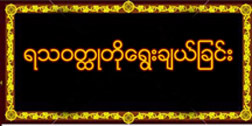Logical (Reasoning)
ME39 07-04-2011 (2:00 to 4:00)
(Class Notes Only)
ME39 07-04-2011 (2:00 to 4:00)
(Class Notes Only)
--------------------
Information on Buddhist law as laid down in the Vinaya-pitak,on the other hand, can be gathered from random references in the Samantapāsādikā or the Kankhavitarani, a commentary on the Pātimokkha, or even in commentaries on other parts of the Tipitaka, As the vast commentarial literature has not been made easily accessible by adequate indices, the
following examples are by no means the result of a systematic search. Although better and clearer evidence still hidden somewhere in the Atthakatha.
following examples are by no means the result of a systematic search. Although better and clearer evidence still hidden somewhere in the Atthakatha.
The Samantapāsādikā descibes in some detail how a legal expert has to act with respect to persons who bring a case before him and with respect to the Vinaya-rules he is going to use.
Once a case (vatthu) is brought before the assembly of monks, plaintiff (codaka) and accused (cuditaka) have to be asked, whether they are going to accept the final verdict. In the case of incompetence, legeal experts have to be invited, who are to be agreed by both parties. These have to decide according to dhamma-vinaya-satthusāsana “teaching- discipline- prescription of the teacher”, the Samantapāsādikā according to the “true cause”, to reproof and remonstration and finally a group of monks capable and competent to decide the case has been established, the hearing proper can begin with the plaintiff stating his case which then has to be examined with all necessary care.
The legal expert has to take the following six points into consideration: the facts (vatthu), the Pātimokkha (mātikā), the commentary on the Pātimokkha (padabhājaniya), ‘the three sections’ (tikepariccheda), the ‘intermediate offense’ (antarāpatti) and the conditions, under which there is no offense (anāpatti). For the Buddha has decided many disputes himself and has given hints how legal experts should decide in future, although all this advice may be of some help for a monk who has to decide a case in agreement with the Vinaya, in the Samantapāsādikā (pārājika- Bāhiranidāna) gives at least an impression how this could have been done:
A certain monk in Antarasamuda (inter of ocean) took a well formed coconut, turned it, and made it into a drinking cup polished like mother-of-pearl. Then he left it behind and went to Cetiyagiri in the Anurādapura.
“antarasamudde kira eko bhikkhu susanthānam nālikeram labhitvā bhamam āropetvā sankhathālakasadisam manoramam pānīyathālakam katvā tattheva thapetvā cetiyagirim agamāsi.”
Antara is means inter, samuda is ocean, kira is indeclinable, eko bhikkhu is a certain(one) monk, susanthānam is well form (good shape), nālikeram is coconut fruit, labhitvā is took, bhamam is turned machine, āropetvā is polish, sankha is couch, sankhathālaka is mother-ofpearl, sadisam is similar,and pānīyathālakam is drinking cup.(tattheva = tattha + eva).
“Suvannata sussaratā, Susantāna surῡpatā. Ᾱbhipacca parivārā, Sabbo me ṫena lobbhoti.”
Another monk went to Antarasamudda, stayed in the very monastery, saw the cup, took it away with the intention to steal it, and went to Cetiyagiri,too.
“Athañño bhikkhu antarasamuddam gantvā tasmin vihāre pativasanto tam thālakam disvā theyyacittena gahetvā cetiyagirimeva āgato” Athañāo bhikkhu (atha+añño) is another monk, gantvā is went, tasmin vihāre is in the very monastery, pativasanto is stayed, disvā is saw, theyyacittena is with the intention to steal mind, gahetvā is took it away and meva is means too.
The monk who originally owned the cup saw the other monk drinking rice-gruel and asked: “Where did you get that?”- “I bought it from antarasamudda.” “Tassa tattha yāgum pivantassa tam thālakam disvā thālakasāmiko bhikkhu āha. “ ‘kuto te idam laddhan’ti” . Antarasamuddato me ānītanti.”
Tassa is means there, yāgum is drinking rice-gruel, sāmiko is originally own, āha is, here asked”, kuto is where and ānītanti is bought. He said “This is not your property. It has been stolen,” and dragged him before the assembly of monks.
“So tam ‘netam tava santakam, theyyāya te gahitan’ti. samghamajjham ākaddhi.” Netam (na-etam) is this is not your property, theyyāya is stolen,samghamajjham is assembly of monks, majjha is middle and ākaddhi is dragged.
There they did not get a decision and went the Mahāvihara. There the drums were beaten. An assembly was held and the hearing (vinicchaya) began. The Elders, who were experts in the Vinaya, decided that it was theft. A member of this assembly was the Elder Godha, the Abhidhamma expert, who was at the same time an expert in the Vinaya.
“Tattha ca vinicchayamalabhitvā Mahāvihāram agamimsu. Tattha bherim paharāpetvā mahācetiyasamāpe sannipātam katvā vinicchayam ārabhimsu. vinayadharattherā avahāram sannīpesum. Tasmim ca sannipāte Ᾱbhidhammika Godattatthero vinayakusalo nāma hoti” Ᾱbhidhammiko is the Abhidhamma expert (scholar), bherim is drums, paharāpetvā is were beaten and vinayakusalo is an expert in the Vinaya.
He spoke thus: “Where has he stolen this cup?”-“It was stolen in Antarasamudda.”- “How much is its value there?”-“It is worth nothing, because coconuts are split there, their contents is eaten, and the shell is thrown away, being considered as something like wood.”-“What is the value of the manual labour of the monk there?”-“A penny (māsaka) or even less than a penny.”-
“Indeed the SammāsamBuddha has prescribed somewhere a Pārājika with regard to a penny or even less than a penny.”
“So evamāha “iminā idaṁ thālakaṁ kuhiṁ avahaṭan”ti. Antarasamudde avahaṭanti. Tatridaṁ kiṁ agghatīti. Na kiñci agghati, tatra hi nāḷikeraṁ bhinditvā miñjam khāditvā kapālaṁ chaḍḍenti, dāru-atthaṁ pana pharatīti. Imassa bhikkhuno ettha hatthakammaṁ kiṁ agghatīti.
Māsakaṁ vā ῡnamāsakaṁ vāti. Atthi pana katthaci Sammāsambuddena māsakena vā ῡnamāsakena vā pārājikaṁ paññattanti. Tatridaṁ=tatra(there) + idaṁ(its or this). This being said there was a unanimous approval: “Excellent, well spoken, well decided!”-
“Evaṁ vutte “sādhu sādhu sukathitaṁ suvinicchitan”ti ekasādhukāro ahosi.”
By Ashin Indaka (Kyone Pyaw)



























